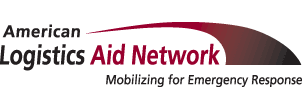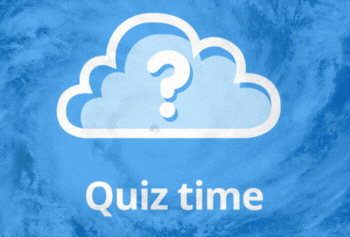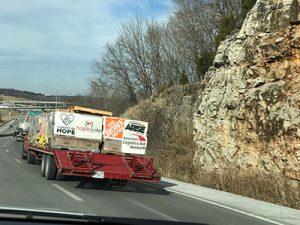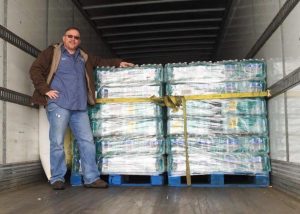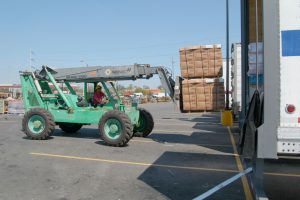In addition to school being in full swing post Labor Day, September is also National Preparedness Month.
Here at ALAN, we’ve already mobilized to help with relief efforts for the Maui wildfires and Hurricane Idalia – and we’re monitoring needs for both Morocco earthquake response and the flooding in Libya. But even after an extremely busy August, it’s not to be forgotten that we’ve officially entered the most challenging months of hurricane season.
In the spirit of National Preparedness Month, we want to do everything we can to help you prepare, including re-acquainting you with some important facts you may have forgotten since the last hurricane “class” was in session.
We’ve put the following test together with that in mind. So get your mouses and keyboards ready –
and let us know how your preparedness scores.
1. On average, how many hurricanes hit the United States each year?
A. 1
B. 5
C. 10
D. Too many to name
B
According to the NOAA, an average of five hurricanes make U.S. landfall each year during a typical three-year period. (Although speaking from our own experience, it often feels like way more than that.)
2. Which of the following is NOT a common hazard created by a hurricane?
A. High winds
B. Earthquakes
C. Storm surge
D. Heavy rainfall
E. Tornadoes
F. Inland flooding
B
We actually had a hard time coming up with a realistic-looking wrong answer to this question, because when you look at hurricanes’ long- and short-term impacts, the list of potential risks is such a long one. That’s why you shouldn’t take the possibility of any hurricane lightly.
3. Which of the following offers free resources for monitoring hurricanes or their supply chain impacts?
A. The National Hurricane Center
B. Your local National Weather Service forecast
C. ALAN’s Supply Chain Intelligence Center
D. All of the above.
D
If you or your business locations are located anywhere near a hurricane’s path, the National Hurricane Center and your local National Weather Service forecast are great resources for storm updates. Meanwhile, ALAN’s Supply Chain Intelligence Center offers detailed real-time updates about hurricanes’ effects on roadways, ports, and airports, including the latest closures.
4. According to FEMA (Ready.gov) how many days’ worth of food, water and other supplies should your emergency preparedness kit for hurricanes or other disasters contain?
A. One
B. Several
C. Ten
D. An unlimited number
B
While there’s certainly no harm in having weeks’ or months’ worth of supplies on hand (especially since you can always share your surplus with folks who aren’t as prepared), FEMA/Ready.gov’s most recently updated baseline for an emergency kit is several days – or longer if you live in an area (like Alaska or Hawaii) that relies on planes or boats for most of its deliveries. For a full list of what types of items should go into this kit, go to Ready Emergency Kit.
5. True or false: If a hurricane isn’t a major one (aka a Category 3, 4 or 5) it’s not necessary to heed requests to evacuate, even if you live directly in its projected path.
False
Even a Category 1 hurricane’s winds are capable of generating dangerous flying debris and destroying buildings and mobile homes – or creating a life-threatening storm surge. Never assume any hurricane will be a walk in the park; all of them have the power to be deadly and destructive, especially for people who don’t take them seriously.
6. What does the Saffir-Simpson hurricane scale measure?
A. Storm size
B. Wind speed – and the possible damage it will have on an area’s infrastructure
C. Miles per hour that a storm is moving
D. Estimated rainfall and flooding
E. Possible storm surge
F. All of the above
B
The Saffir-Simpson scale was created to help explain and quantify the damage that buildings will sustain during different wind speeds. It does not measure any of the other hazards or factors we named. So please, don’t judge a hurricane’s potential dangers – or make your decision about how to prepare – based on Saffir-Simpson category alone.
7. True or False: It’s possible for a hurricane to create damage to an area or put an area’s residents at risk even if it doesn’t directly make landfall there.
True
Hurricane-force winds can extend anywhere from 25-150 miles beyond the area that a hurricane directly passes through. And tropical storm force winds, which can also be highly dangerous and damaging, can extend even farther. In addition, storm surge can be present miles away from a storm’s landfall. So don’t think you’re off the hook in terms of making hurricane preparations just because you’re not located directly in a hurricane’s path – or because you don’t live directly on the water. Inland communities can also be at risk, especially for the hazard that’s mentioned in the next question.
8. What is the greatest hurricane-related safety hazard?
A. Wind damage
B. Flying debris
C. Storm surge and flooding
D. Water-borne disease
C
Hurricane winds can obviously pack a wallop. But it’s actually hurricanes’ storm surge and dangerous flood waters that result in the highest direct death tolls (88% of all hurricane-related fatalities). Go to https://floodfind.com/ to view areas at high risk for potential flooding – and always follow local safety officials’ instructions about whether (and when) to evacuate. Additionally, always heed the “turn around, don’t drown” rule if you come across water on roadways; don’t attempt to drive through it.
9. Fill in the blank: Many items that are donated to product collection drives wind up in ____ rather than hurricane survivors’ hands.
A. Landfills
B. Toledo
C. Garage sales
D. Their original location
A
Sadly, even some of the most practical items that people donate to post-disaster product collection drives often go to waste. The reasons for this are myriad, which is why we encourage you to read Collection Driving Me Crazy for more details – and to consider giving money or donating your logistics services and equipment to help with hurricane relief efforts instead, especially in a hurricane’s immediate aftermath.
10. Why do relief organizations like ALAN ask you to refrain from self-deploying to a community that has been hit by a hurricane?
A. We want all of the credit for helping.
B. You could be putting yourself in harm’s way.
C. You could get in the way of rescue and relief efforts.
D. B and C
D
People who self-deploy to disaster sites often create more challenges than they solve, adding superfluous products and people to a supply chain that’s already under tremendous strain. Ultimately, there are many more meaningful ways (like sending cash or donating trucking, warehousing and material handling equipment) that you can be of immediate help – and that will support, rather than get in the way of, rescue and relief efforts.
11. Logistics expenses account for as much as what percentage of post-disaster relief costs?
A. 10
B. 20
C. 40
D. 80
D
Many factors make post-disaster logistics extremely expensive (accounting for up to 80% of all disaster relief spending) and difficult to execute, including damaged roadways, last-minute shifts in a disaster’s path, flooded conditions and sudden, massive surges in demand. These hurdles often prevent disaster relief organizations from being able to use their logistics budgets as effectively as possible. And that, in turn, means that up to 40% of these well-intended efforts go to waste. It’s one reason why donated logistics space and services are so valuable.
12. True Or False: ALAN doesn’t pre-deploy to hurricane sites because it’s impossible to predict exactly what will be needed – and where.
True
Even though all hurricanes have many things in common, they all wind up having many different outcomes and pain points. And you really can’t predict what those will be – and where relief organizations will require supply chain assistance the most – until after a hurricane has moved through.
For example, some areas may have a compromised water supply, while others may have a more immediate requirement for items to assist with flood rescues. Meanwhile, certain areas may suffer more property damage and loss, which may lead to a greater need to help support and supply hurricane shelters. It really runs the gamut – and can change from hour to hour – which is why everything we do is tied to a direct ask from a reputable relief organization that’s actively providing relief.
13. Fill in the blank: Communities need help with hurricane relief _____ after hurricanes hit.
A. Hours
B. Days
C. Weeks
D. Months
E. Years
F. All of the above
F
All of the above. While some aspects of hurricane relief start taking place immediately, others (like clean-up and rebuilding) tend to occur considerably later down the line. All of that is to say, if your company doesn’t have an opportunity to immediately help after a hurricane, hang tight. Your assistance could be exactly what’s needed later down the line.
How did you score? Was it harder than anticipated? If you have any questions, reach out to us today. Our team would be happy to pass along additional hurricane safety and preparedness information.
Thanks for playing – and stay safe this Hurricane Season!
